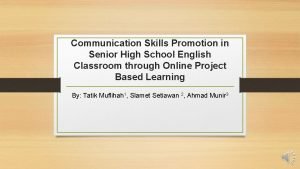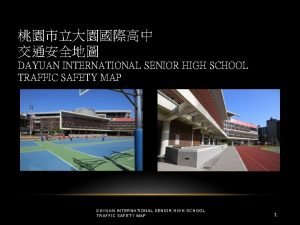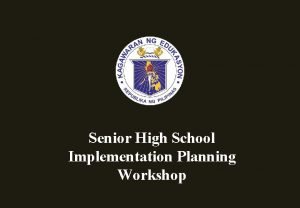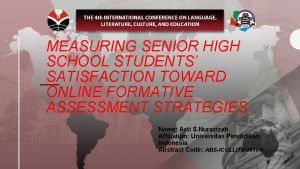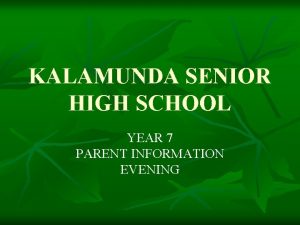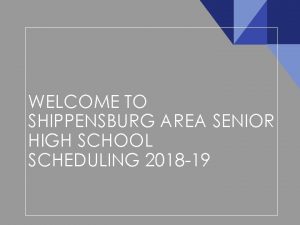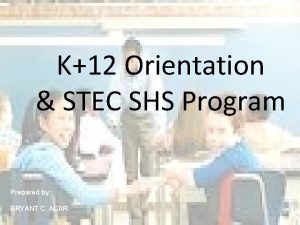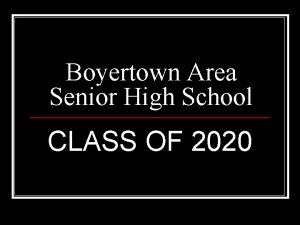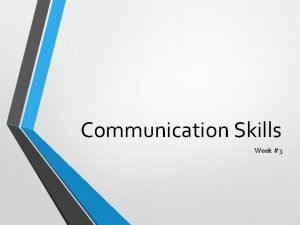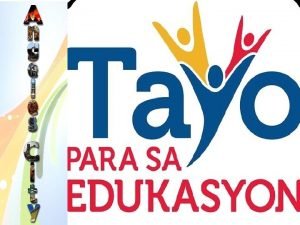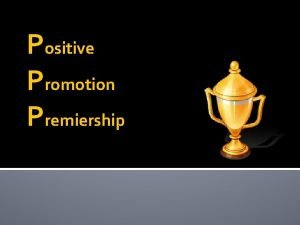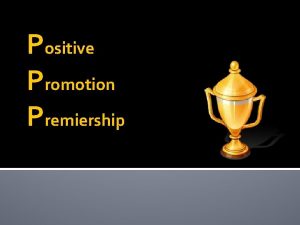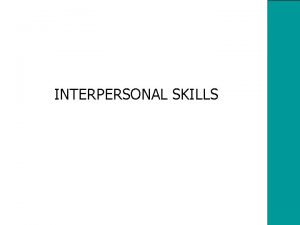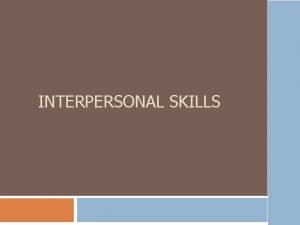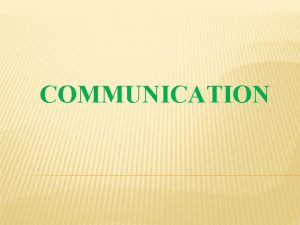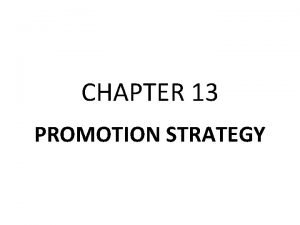Communication Skills Promotion in Senior High School English




















- Slides: 20

Communication Skills Promotion in Senior High School English Classroom through Online Project Based Learning By: Tatik Muflihah 1, Slamet Setiawan 2, Ahmad Munir 3

Introduction • Industrial revolution era 4. 0 is characterized by technology to be the basis of human life. • In education, the 21 st century learning, students should be qualified and competent at the development of technology. • Learners should master learning and innovation skills or 21 st century skills which involves critical thinking, collaboration, communication, and creativity (4 C’s) (P 21, 2015) • 4 C’s need to be developed in academic subject knowledge and students’ understanding

Introduction cont. . • English is one of the core subjects among others namely; World languages, Arts, Mathematics, Economics, Science, Geography, History, Government and Civics (P 21, 2009). • To match the demand of 21 st century learning, education should be integrated with modern technology (Inthachot , 2013) • Deals with the current situation of Covid-19 Pandemic, Indonesian Government has policy to hold education in online setting • This study used Online Project Based Learning

Introduction cont. . • A study conducted by (Chalak, 2015) indicated that the implementation of online PBL increase students’ vocabulary and speaking skill. PBL offered joyful atmosphere thus learners experienced less anxiety in learning. • Kovalyova, Soboleva (2016) revealed that PBL is an ideal teaching method as it improves engineering students’ oral and written communication skills. • Saenab, Yunus (2019) uncovered that PBL enhances students’ communication abilities in Science Education Program. • In ELT context, Kurniawati, Susanto, Munir (2019) have found that the implementation of PBL promotes students’ communication skills especially in communicating ideas with others.

What is PBL?

• PBL is an experiential learning (Brown & lee, 2015; Eyring, 1991) • A teaching approach that engages students by providing challenge or project as a means of gaining new knowledge or skills (Larasati, 2015) • 2013 Curriculum, PBL was suggested as one of the innovative approaches in teaching and learning English (Kemendikbud, 2016)


Communication is one of the essential competencies of 4 C’s: Collaboration, Critical thinking, and Creativity (P 21, 2015). Teaching and learning process will be successful when communication in the classroom among the teacher and the students or the students with other run on well (Fashiku, 2017). Five communication skills indicators(Greenstein, 2012)

Method Synchronous electronic interaction: Whattsapp & Google Classroom (GCR) Qualitative Descriptive Subject 6 students of private Senior High School in Surabaya Data: Students’ Conversation screen recorder and Voice Note recorder

Results • Table 2. Result of Students Ability to Communicate Ideas • The results indicated that students reach all the five indicators of communication skills adapted from Greenstein (2012). • The results of the present study are in line with the previous study conducted by (Kurniawati, Susanto, Munir, 2019) that students’ communication skills promotion can be reached through the implementation of PBL.

Discussion • The PBL in this study is e-poster making. • Some experts’ defined project based learning as experiential learning, they are (Brown& lee, 2015; Eyring, 1991). • This idea was support by Knutson (2003) that experiential learning occurs when students engage in doing a project or task. • In this study, the process of e-poster making involves students’ expose their communication skills such as share ideas, discuss the topic, and solve the problem. In e-poster making process, it is possible for students connect earlier experiences with the new one. This process indicates project based learning is experiential learning (Brown& lee, 2015; Eyring, 1991).

Example • Example 1: (Indicator 1) S 1: Gimana kalau "Peran sosial media di era pandemi covid 19" (What if “the role of social media in Pandemic Covid-19 era? ) S 4: Boleh (Ok) S 3: Boleh Juga (that’ s Ok) • Example 1 indicates S 1 stated his idea clearly. He offered theme of eposter namely ‘What if theme of e-poster was the role of social media in pandemic covid-19 era’. This opinion was accepted by other members. S 4 and S 3 replied that S 1’s idea about the title was Ok. This shows that S 1 has able to state his opinion clearly so that other member group understand. I addition, the other member group can positively respond his idea. In other words, this example revealed that the first indicator can be reached.

Example 2: (Indicators 2) S 4: Hai, Judulnya macem mana? "How to use socmed in a good way" Gitu? Reeek, Gimanaaaaa? (Hi, Guys. How about the title? “How to use socmed in a good way” isn’t it? Guys, what do you think? ) S 6: How sosmed killed me (How social media killed me? ) S 4: Ya masa gitu (are you sure? ) S 6: Kalo pake 3 rd person, the Bullied (If uses 3 rd person, the bullied) In this conversation, S 4 stated her opinion about the title of their project. She stated: ‘How about the title? “How to use social media in a good way” isn’t it? Guys, what do you think? ’ In responding this, S 6 also mentioned her idea about the title by saying ‘How social media killed me? ’ S 4 was doubtfully on S 6’s idea. S 4 said: are you sure? S 6 replied: ‘If uses 3 rd person, the bullied’ S 6. From S 6 explanation, it can be seen that she was trying to convince S 4 about her opinion. This conversation reflects that students in the group used persuasive communication in order to convince other. Then the second indicators was achieved by the group.

• • Example 3: (Indicator 3) S 2: Emang jadi milih yang apa? (What is the chosen work) S 4: Narativ bukannya? (Narrative, isn’t it? ) S 6: Yeup, Biasanya bikin poster pake apa (Yupp. What type of platform commonly used for e-poster making) • S 2: Kalau hp bisa pixellab ato, Pics. Art, kalo lp pake Photoshop bisa (Pixellab or Pics. Art can be used in cellular phone, while Pics. Art can be used in notebook ) • S 4: Pake canva juga bisa (Canva can also be used) • S 2': Enak canva aja kalo gitu, udah ada templatenya (Canva is better, it provided with template ) • S 4: Iya, Pake canva aja (ok, Canva) • In this example S 6 asked her friends the common application for e-poster making. S 2 answered that Pixellab or Pics. Art can be used in cellular phone, while Pics. Art can be used in notebook. S 4 added the similar thing that Canva can also be used. From this conversation, it can be seen that the students used accurate sources by showing their understanding about some application commonly used for e-poster making. Briefly, this can be concluded that students especially S 2 and S 4 had reached the third indicator.

Example 4: (Indicator 4) S 1: Oalah iya Aku bingung harus bantu Yang bagian mana. . Udah di translate semua (ouch…I am confused, which part can I take apart? Everything has already translated. Emoticon) S 2: Cek grammar aja (You can check grammar. Emoticon) S 1: Udah clear semua gitu (Everything is clear) Explanation: S 1 stated his feeling by saying: ‘ouch…I am confused, which part can I take apart? Everything has already being translated (emoticon)’. He used emoticon to show his feeling because he did not give a great contribution on the group work. S 2 replied that he can still help the group by checking the result of group work. S 2 added visual emoticon to make sure that it is not a problem if S 1 wanted to support the group. This indicates that students fulfilled indicators: use verbal and visual communication

• Example 5: Indicator 5 • S 2: Jadi di posternya mau dicantumin apa aja? Dampak negatif sm positif nya gitu ta? (So, what should be attached to the poster? positive and negative impact, what do you think? ) • S 4: Iyaa, Sama kasih pengertiannya dulu (yes, that’s right, the definition should be put in the first part) • S 2: Oke, trs apa lagi? Temen 2 ada usulan? (Ok friends, what’s next? Do you have any ideas? ) • S 3: Manfaatnya juga mungkin? (What about the benefits? ) • S 4: Cara menggunakan sossmed dengan baik gitu gimana? (the best way to use socmed, what do you think? ) • S 2: Kalo manfaat apa ngga sm kaya dampak positif? (Is the benefit the same as the positive impact? In Example 6 S 2 asked the group about the things that should be stated in the e-poster. S 4 answered that it should be added definition. S 4’s statement indicates that she was listening to and paying attention to S 2. In the next part of the example, S 2 asked about her friends’ opinion. S 3 answered it should be added the benefits. S 4 replied the best way to use social media. S 3 and S 4 had showed acceptable communication skills by responding S 2 questions. In the last part of example 6 S 4 asked: ‘what do you think? ’ S 2 replied: Is the benefit the same as the positive impact? S 4 and S 3 responded that those are the same. All of the answers by S 2, S 4, and S 3

Conclusion • The online Project Based Learning is substantially applicable in students’ communication skills promotion.


References Partnership 21 st Century Skills (P 21), (2015). 2. Inthachot M, Sopeerak S, Rapai N. The Development of a U-Learning Instructional Model Using Project Based Learning Approach to Enhance Students’ creating-innovation skills Procedia - Social and Behavioral Sciences 2013; 103: 5. 3. Bell S. Project-Based Learning for the 21 st Century: Skills for the Future. The Clearing House. 2010; 83: 4. 4. Simpson J. Integrating Project-Based Learning in an English Language Tourism Classroom in a Thai University. Australia: Australian Catholic University; 2011. 5. Zhou Z. An Empirical Study on the Influence of PBL Teaching Model on College Students’ Critical Thinking Ability English Language Teaching. 2018; 11(4): 5. 6. Kavlu A. Implementation of Project Based Learning (PBL) in EFL (English as a Foreign Language) Classrooms in Fezalar Educational Institutions (Iraq) International Journal of Social Sciences & Educational Studies 2017; 4(2): 13. 7. Alam Q, Uddin DAB. Improving English Oral Communication Skills of Pakistani Public School's Students International Journal of English Language Teaching 2013; 1(1): 20. 8. Wongdaeng M, Hajihama S. Perceptions of Project-Based Learning on Promoting 21 st Century Skills and Learning Motivation in a Thai EFL Setting j. SEL. 2018; 13(2): 33. 9. Yaali F, Chalak A. Impact of Online Project Work on Iranian Pre Intermediate EFL Learners’ Productive Skills and Retention Journal of Language and Literature. 2015; 6(4): 5. 10. Kovalyova YY, Soboleva V, Kerimkulov AT. Project Based Learning in Teaching Communication Skills in English as a Foreign Language to Engineering Students i. JET. 2016; 11(4): 4. 11. Saenab S, Yunus SR, Saleh AR, Virninda AN, L H, Sofyan NA, editors. Project-based Learning as the Atmoshphere for Promoting Students’ Communication Skills 2 nd International Conference on Statistics, Mathematics, Teaching, and Research 2018: IOP Publishing 12. Kurniawati FN, Susanto, Munir A. Promoting Students' communication Skills through the Application of project Based Learning Linguistic, English Education and Art (LEEA) Journal 2019; 3(1): 19. 13. Silabus Mata pelajaran Sekolah Menengah Atas/Madrasah Aliyah (SMA/MA) Mata Pelajaran Bahasa dan Sastra Inggris (Peminatan)(PEMINATAN)(2016). 1.

References (2) 14. Brown HD, Lee H. Teaching by principles: An interactive approach to language pedagogy New York: Pearson Education Inc. ; 2015. Eyring JL. Experiential language learning. Murcia MC-, editor. Boston: Heinle& Heinle; 1991. 346 -57 p. 16. Knutson S. Experiential learning in second-language classrooms. TESL Canada Journal. 2003; 20(2): 13. 17. Lam NTV. Project-based learning in teaching English as a foreign language VNU Journal of Science, Foreign Languages. 2011; 11: 6. 18. Larasati A. Improving Students' Writing Skills through Project -Based Learning Techniques at Grade XI of SMAN 2 Sleman in the Academic Year of 2014/2015 Yogyakarta: Universitas Negeri Yogyakarta; 2015. 19. Torres AMV, Rodríguez LFG. Increasing EFL Learners’ Oral Production at a Public School Through Project-Based Learning. PROFILE 2017; 19(2): 15. 20. Framework for 21 st Century Learning, (2009). 21. Rawat MD. Importance of Communication in Teaching learning Process Scholarly Research Journal for Interdisciplinary Studies. 2016; 4(26): 6. 22. Fashiku CO. Effective Communication : Any Role in Classroom Teaching-learning process in Nigerian School? . Bulgarian Journal of Science and Education Policy. 2017; 11(1): 17. 23. Lee L. Enhancing Learners’ Communication Skills through Svnchronous Electronic Iiteraction and Task-Based Instruction Foreign Language Annals 2002; 35(1): 9. 24. Winasih WW, Cahyono BY, Prayogo JA. Effect of Project-Based Learning Using E-Poster on Indonesian EFL Students’ Speaking Ability across Personality Types Arab World English Journal (AWEJ). 2019; 10(1): 11. 25. Greenstein L. Assessing 21 st Century Skills: A Guide to Evaluating Mastery and authentic Learning. California: Corwin A sage Company; 2012.
 Communication skills of senior high school students
Communication skills of senior high school students Scarborough high school principal
Scarborough high school principal Gearing up for the future (senior high school)
Gearing up for the future (senior high school) Dayuan international senior high school
Dayuan international senior high school Children who release unexpressed anger toward
Children who release unexpressed anger toward Paul d schreiber high school
Paul d schreiber high school Smsh south miami
Smsh south miami Humss sample schedule
Humss sample schedule Humss course
Humss course Sample accomplished erf form
Sample accomplished erf form Gibbs senior high school
Gibbs senior high school Chatsworth senior high school
Chatsworth senior high school Naviance potomac senior high school
Naviance potomac senior high school Socartive
Socartive Kalamunda senior high school
Kalamunda senior high school Welcome to your senior year of high school
Welcome to your senior year of high school Shippensburg area senior high school
Shippensburg area senior high school Miami killian senior high school rating
Miami killian senior high school rating K12 orientation
K12 orientation Carroll senior high school counselors
Carroll senior high school counselors Boyertown senior high
Boyertown senior high
